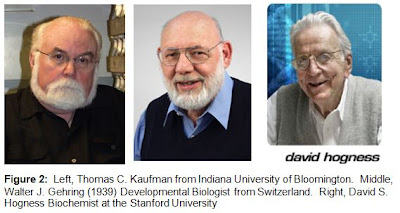Ernst Haeckel (1834-1919) was a German biologist-philosopher,
who worked with different scientific areas. He introduced new names for his
discoveries in different scientific fields such as the terms ecology,
anthropogeny, phylum, the kingdom
Protista, phylogeny, stem cell and also proposed the Recapitulation1
Theory.
The Recapitulation Theory was proposed to create a synthesis on basis of Lamarckian and
Darwinism theories. The Recapitulation
Theory says:
“the ontogeny2
recapitulates phylogeny3”,
(look the image above) which it means that the whole development
process repeats or resemble the complete successive evolutionary stages,
beginning with his common ancestor passing through several organism that he had
already evolved until reach his own proper form. It’s said, when an organism is
developing, he remakes and pass through every embryonary development stage that
compound his whole evolutionary lineage-history. In other words, each of the
individual states of a species crosses throughout embryonic development,
represents one of the adult forms that appeared in their evolutionary history. For
example, Haeckel proposed that the pharyngeal grooves between the pharyngeal
arches in the neck of the human embryo resembled gill slits of fish, thus
representing an adult "fishlike" developmental stage as well as
signifying a fishlike ancestor. Ernst Haeckel made drawings of his observation
studies and there were several controversies about Haeckel drawings where he
shows the variety of embryology resembling between organisms. There was several
misunderstanding about his work at that time.
During the nineteenth century, there were several scientists
agree with Haeckel’s ideas “that all vertebrates looked very similar at an early
stage, in what was thought of as a common ideal type”. But others differ
proposing different perspectives views like Karl Ernst von Baer. He thought “the
early general forms diverged into four major groups of specialized forms
without ever resembling the adult of another species, showing affinity to an archetype (is a universally understood
symbol, term) but no relation to other types or any Transmutation of species
(theory that described the altering of one species into another)”.
 |
| Figure 2. The chicken don't recapitulates his adult ancestors such as it was formulated by Ernst Haeckel. |
- recapitulation: to restate briefly : summarize; to repeat the principal stages or phases of something.
- ontogeny: ontos means: “to be” and geny means “mode of production”; the history of structural change in a unity, which can be a cell, an organism, or a society of organisms, without the loss of the organization which allows that unity to exist.
- phylogeny: is the story of the evolutionary development of a group of organisms.
References:
- Embryo Project Encyclopedia. 2007. Retrieved August 2011. "In 1874 His published his Über die Bildung des Lachsembryos, an interpretation of vertebrate embryonic development. After this publication His arrived at another interpretation of the development of embryos: the concrescence theory, which claimed that at the beginning of development only the simple form of the head lies in the embryonic disk and that the axial portions of the body emerge only later."
- Ernst Haeckel — Britannica Concise (biography) Encyclopædia Britannica Concise, 2006.
- Evolution and Development for the 21st Century. Retrieve on Sunday, march 31 2013 from: Stephen Jay Gould http://evolution.berkeley.edu/evosite/history/modevdev.shtml
- Learning about evolutionary history. Retrieve on Sunday, march 31 2013 from: http://evolution.berkeley.edu/evolibrary/article/0_0_0/evodevo_02
- Michael K. Richardson. 1998. "Haeckel's embryos continued." Science 281:1289, quoted in NaturalScience.com webpage Re: Ontogeny and phylogeny.
- Richardson MK, Hanken J, Selwood L, Wright GM, Richards RJ, Pieau C, Raynaud A (1998). "Letters". Science 280 (5366): 983, 985–6.














